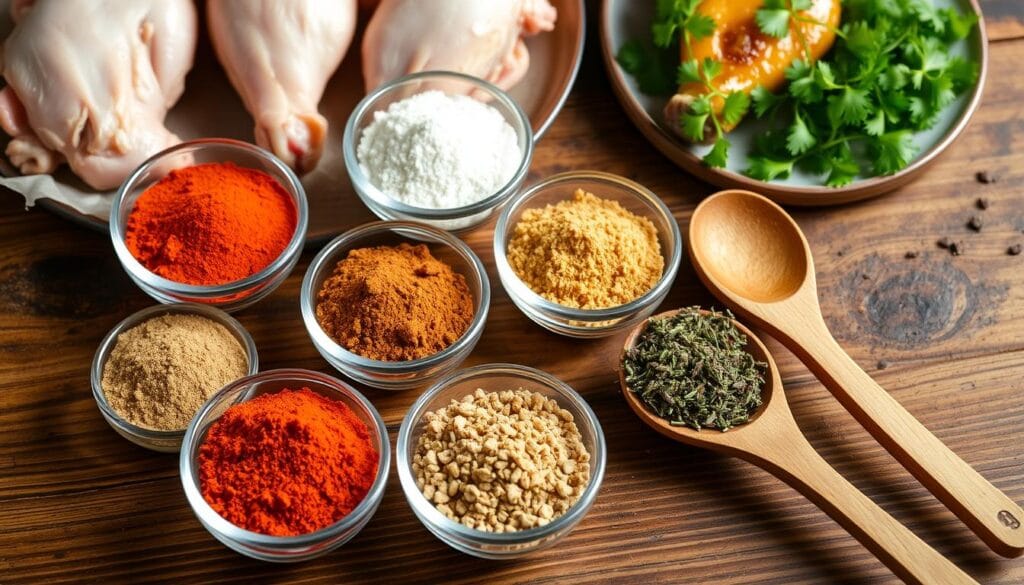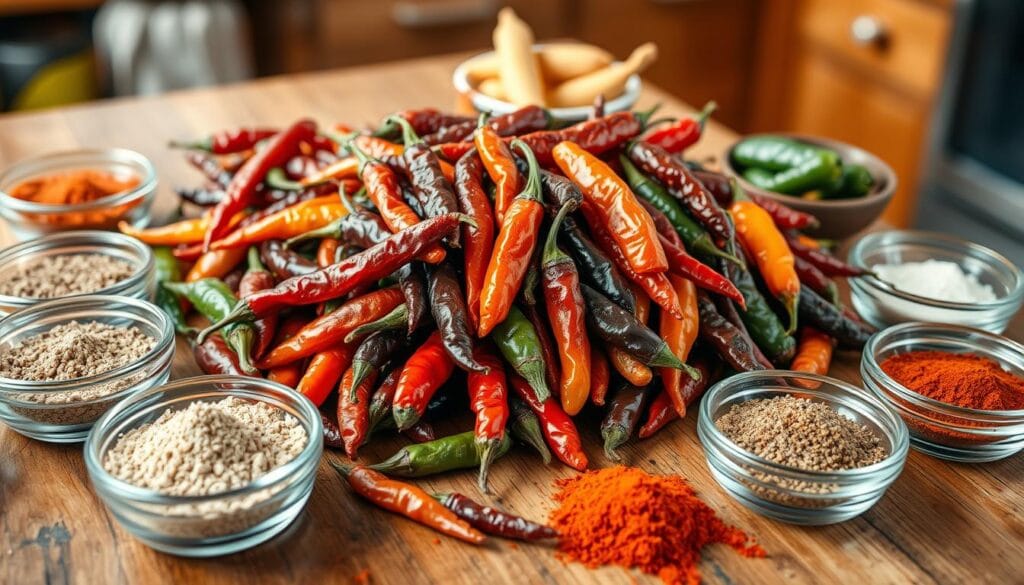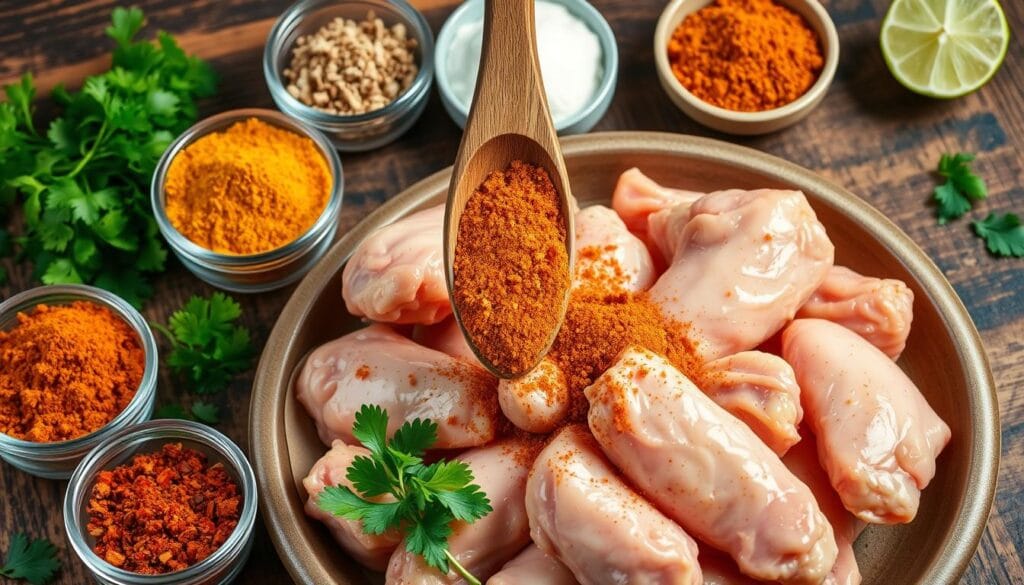Essential Ingredients for a Tasty Homemade Chicken Wing Rub
I love wings, and I know the secret to great ones. It’s all about the homemade spice blend. Forget store-bought stuff. With simple pantry items, you can make a rub that will impress everyone.

A great chicken wing rub needs the right mix of flavors. Think smoky paprika and zesty garlic. Knowing how to mix these will make your wings unforgettable.
Table of Contents
Understanding the Basics of Wing Seasoning
Creating delicious chicken wings starts with the right seasoning blend. Dry rubs are better than wet marinades because they quickly add flavor. The rub’s spices and herbs mix with the chicken’s juices, creating a crispy crust.
The Science Behind Flavor Development
Getting the most flavor means balancing spices carefully. Smoked paprika adds a warm, earthy taste. Chipotle powder brings smokiness and a bit of heat. Mixing these with onion powder, garlic powder, and brown sugar makes the chicken taste amazing.
Why Dry Rubs Are Superior to Wet Marinades
Dry rubs beat wet marinades for chicken wings. They quickly add bold flavors. Wet marinades can make the skin soggy. Letting wings sit with the dry rub for 15-30 minutes before cooking ensures great flavor.
The Role of Spice Balance
Finding the right spice balance is key for a great barbecue rub or wing marinade. The mix of savory, sweet, and spicy flavors makes a rub stand out. By blending the right flavor enhancers, you can make your chicken wings unforgettable.
Must-Have Base Spices for Your Chicken Wing Rub
Creating the perfect chicken wing dry rub starts with a mix of essential spices. These spices form the flavor base that you can then tweak to your liking. Let’s look at the key spices for your homemade poultry seasoning.
The quintessential spices for a delicious chicken wing dry rub include:
- Paprika – Preferably smoked paprika, which lends a rich, earthy depth to the rub.
- Garlic Powder – Adds a savory, aromatic punch.
- Onion Powder – Adds a hint of sweetness and depth of flavor.
- Salt – Enhances all the other flavors and aids in tenderizing the meat.
- Black Pepper – Delivers a gentle heat and peppery notes.
You can also add other spices to make your chicken wing dry rub even better:
- Chili Powder – Lends depth and mild heat.
- Oregano – Adds an earthy, slightly minty note.
- Cumin – Imparts a warm, slightly nutty flavor.
Mastering this spice blend will give you the tools to make a delicious chicken wing dry rub. It will turn your wings into a flavor explosion. Play with the amounts to get the perfect mix of savory, smoky, and spicy.
The key to an outstanding chicken wing dry rub is in the perfect balance of a few essential spices, coming together to craft an irresistibly flavorful profile.
The Secret to Achieving Crispy Wings: Baking Powder
Baking powder is the secret to making baked chicken wings crispy without deep frying. It changes the chicken skin’s pH level, promoting browning and crisping. This results in a delightfully textured wing.
How Baking Powder Affects Chicken Skin
Baking powder’s magic is simple yet smart. It increases the chicken skin’s pH level, breaking down proteins. This lets moisture evaporate faster, making the skin crispier and golden.
Proper Ratios for Optimal Crispiness
- For the best crispiness, mix 1 tablespoon of baking powder with 1.5 tablespoons of primary spices in your grilling seasoning or chicken wing rub.
- This ratio balances crispiness with bold flavors, making your homemade wings taste like they’re from a restaurant.
- Always sift the baking powder to avoid clumps and ensure even coating for maximum crispiness.
Adding baking powder to your chicken wing rub or seasoning makes wings crispy. Your guests will be impressed by your cooking skills.
Heat and Smokiness: Choosing the Right Peppers
Make your homemade chicken wing rub better by adding the right peppers. Cayenne pepper adds a spicy kick. Smoked paprika gives a smoky taste, like grilled wings. Chili powder adds mild heat and a rich, earthy flavor.
Controlling the spice level is all about cayenne pepper. Start with 1-2 teaspoons per batch. Then, add more until it’s just right. Remember, a little cayenne is a lot, so start small and adjust.
| Pepper Type | Scoville Heat Units (SHU) | Flavor Profile |
|---|---|---|
| Cayenne Pepper | 30,000 – 50,000 SHU | Spicy, with a moderate heat that builds over time |
| Smoked Paprika | N/A (Not a measure of heat) | Smoky, with a sweet and slightly earthy flavor |
| Chili Powder | 1,500 – 2,500 SHU | Mild heat with a complex, slightly fruity taste |
By mixing cayenne, paprika, and chili powder, you make a spice blend that boosts your barbecue rub. It takes your chicken wings to a whole new level of flavor.
“The right combination of peppers can transform a simple chicken wing rub into a culinary masterpiece.”

Creating the Perfect Chicken Wing Rub
To make the perfect chicken wing rub, you need to measure and mix carefully. Start by gathering your spices and seasonings in a small bowl. Measure each ingredient carefully, as the right balance is crucial for developing mouthwatering flavor.
Once you have all the components, use a whisk or fork to mix the dry rub thoroughly. This ensures even distribution of the chicken seasoning.
Measuring and Mixing Techniques
When preparing your dry rub, it’s important to measure the spices accurately. Using the correct ratios will help you achieve the desired taste and texture. For optimal results, use a digital scale or measuring spoons to portion out the ingredients precisely.
After mixing, give the rub a few good stirs to blend the flavors together seamlessly.
Storage and Shelf Life Tips
To maintain the freshness and potency of your chicken seasoning, store the dry rub in an airtight container. A mason jar or resealable bag works well. Store it in a cool, dry area, out of direct sunlight.
The dry rub can be stored for up to 3 months. But be sure to give it a stir before each use, as the spices may settle over time.
Scaling Your Recipe
If you need to make a larger batch of the chicken wing rub, simply scale the recipe. Double or triple the ingredient quantities. This will allow you to have a ready-to-use seasoning on hand for future wing-making sessions.
Modify the ratios to match your personal taste. Ensure the perfect balance of flavors.
| Ingredient | Amount |
|---|---|
| Chicken wings | 2 lbs (1 kg) |
| Flour | 1/2 cup |
| Brown sugar | 1 1/2 tbsp |
| Cayenne pepper | 1 tsp |
| Chili powder | 1 tsp |
| Onion powder | 1 tsp |
| Garlic powder | 1 tsp |
| Dried oregano | 1 tsp |
| Sea salt | 2 tsp |
| Ground pepper | 1 tsp |
| Olive oil | 2 tbsp |
With these tips in hand, you’ll be well on your way to crafting the perfect chicken seasoning and dry rub for your homemade chicken wings. Experiment with different spice blends and adjust the ratios to find your signature flavor profile.
Essential Herbs and Aromatics for Depth
Make your homemade chicken wing rub better by adding fragrant herbs and aromatics. These ingredients can make your wings taste more complex and interesting. Try different herbs and aromatics to find the perfect mix that will impress your guests.
Oregano is a great herb for chicken wing rub. It has an earthy, slightly peppery taste that goes well with the chicken. For a fresh taste, add thyme. Rosemary adds a woodsy flavor that’s perfect for chicken.
Dried aromatics like minced onion and garlic flakes also add depth to your seasoning. They make the flavor more complex and robust.
| Ingredient | Flavor Profile | Suggested Usage |
|---|---|---|
| Oregano | Earthy, slightly peppery | 1-2 teaspoons, dried |
| Thyme | Piney, fresh | 1 teaspoon, dried |
| Rosemary | Woodsy, resinous | 1/2 teaspoon, dried |
| Minced Onion | Savory, aromatic | 1 tablespoon |
| Garlic Flakes | Pungent, nutty | 2 teaspoons |
Try mixing different herbs and aromatics to find the best combination. With a bit of creativity, you can make a poultry seasoning that not only boosts the flavor enhancer of your chicken wings but also excites your taste buds.
Application Techniques and Timing
Getting the perfect chicken wings starts with how you apply the dry rub. Start by patting the wings dry with paper towels. This helps the rub stick better. Use 1 to 2 tablespoons of chicken wing dry rub for each pound of wings.
To coat the wings well, put them in a large zip-top bag with the rub. Seal and shake until they’re fully coated. Or, toss the wings in a bowl with the rub, making sure they’re seasoned evenly.
Pre-cooking Preparation Methods
After applying the wing marinade, let the wings sit for 15 to 30 minutes. This allows the flavors to penetrate the meat. For crispiness, place the wings on a wire rack over a baking sheet and refrigerate for 30 minutes to 1 hour before cooking.
Best Practices for Even Coverage
To coat every inch of your chicken wings, follow these tips. Work in small batches for even seasoning. Use a spice shaker or sifter to dust the rub over the wings. This ensures a uniform coating.
| Dry Rub Ingredient | Quantity |
|---|---|
| Smoked Paprika | 1 tablespoon |
| Baking Powder | 1 tablespoon |
| Brown Sugar | 2 teaspoons |
| Garlic Powder | 1 teaspoon |
| Onion Powder | 1 teaspoon |
| Chili Powder | 1 teaspoon |
| Salt | 1 teaspoon |
| Black Pepper | 1/2 teaspoon |
You can store the dry rub in an airtight container for up to six months. This makes it easy to have on hand for your next chicken wing craving.

Customizing Your Wing Rub for Different Flavor Profiles
Making your own chicken wing rub is fun because you can change it up. You can adjust the spices or add new ingredients. This way, you can make many tasty flavors for any occasion. Here are some tips to enhance your wing seasoning.
Sweet and Savory Twist
To make your wing rub sweeter, add brown sugar or coconut sugar. These sugars add a caramelized taste that goes well with savory spices. Begin with 1-2 tablespoons and adjust to your liking.
Smoky and Spicy
Try different paprikas to deepen your wing rub’s flavor. Hungarian paprika gives a bold taste, while Spanish paprika adds a smoky hint. Mix these with cayenne pepper or chili powder for a spicy kick.
Herbal Infusion
Adding dried herbs like thyme, rosemary, or basil can give your rub a Mediterranean twist. Chop or grind the herbs well for even flavor. Use 1-2 teaspoons per batch and adjust to your liking.
Asian-Inspired Twist
For an Asian-style wing rub, use five-spice powder, garlic powder, ginger, and soy sauce. This mix of spices, savory umami, and sweetness will take you to the Far East.
Remember, the best wing rub comes from trying new things. Begin with small batches and taste along the way. Keep adjusting until you find your perfect flavor. Enjoy experimenting and finding new flavors with each batch.
| Ingredient | Quantity | Nutritional Value (per 1 tbsp) |
|---|---|---|
| Chicken Wings | 5 lbs | Protein: 86% Fat: 55% |
| Dry Rub | 5 tbsp | Calories: 18kcal Carbohydrates: 4g Protein: 1g Fat: 0.3g Sodium: 1404mg Potassium: 72mg |
“The Works” seasoning blend by PS Seasoning incorporates flavors like pickles, mustard, ketchup, and onion, offering a unique twist on classic burger flavors.
Exploring spice blends and grilling seasoning opens up endless possibilities. Be creative and find the flavors that make your taste buds happy.
Conclusion
Making your own chicken wing rub lets you pick the flavors you like best. You can get the wings just right, crispy on the outside and tender inside. Start by learning about spice blends and baking powder to make a great dry rub.
Try out different spices, peppers, and herbs to create your own special mix. This way, you can make wings that taste exactly how you want them.
Getting the wings to taste great and stay crispy is all about how you prepare them. Make sure to coat them well and let the rub soak in before cooking. Also, adjust the recipe for how many wings you’re making and how big you want them to be.
Whether you love classic Buffalo wings or want to try something new, a homemade rub can make your wings amazing. Use the right spices, herbs, and baking powder to impress everyone at your next event or game day.
FAQ
What are the essential ingredients for a homemade chicken wing dry rub?
To make a great chicken wing dry rub, you’ll need chili powder, smoked paprika, and garlic powder. Onion powder, sea salt, and black pepper are also key. Don’t forget baking powder for crispiness. Cayenne pepper adds a spicy kick.
Why are dry rubs preferred over wet marinades for chicken wings?
Dry rubs are better than wet marinades because they flavor wings quickly. They also help create a crispy outside. The right mix of spices is important for great taste.
What are the base spices for a chicken wing dry rub?
The main spices for a chicken wing dry rub are smoked paprika, garlic powder, onion powder, salt, and black pepper. These spices form a solid base that you can tweak to your liking.
How does baking powder help achieve crispy chicken wings without deep frying?
Baking powder is the secret to crispy wings without deep frying. It changes the chicken skin’s pH, helping it brown and crisp up. Use 1 tablespoon of baking powder for every 1.5 tablespoons of main spices.
What types of peppers can be used to add heat and smokiness to a chicken wing rub?
Cayenne pepper adds heat, while smoked paprika gives a smoky taste like grilled wings. Chili powder brings a touch of heat and enhances the flavor. Adjust the cayenne pepper to your desired spiciness.
How should the chicken wing rub be stored and scaled for larger batches?
Keep the dry rub in an airtight container, like a mason jar, in a cool, dry spot for up to three months. Stir it before using, as spices settle. For bigger batches, just double or triple the recipe or adjust the spice ratios to your taste.
What herbs and aromatics can be added to a chicken wing rub for additional depth of flavor?
You can add fresh or dried herbs like oregano, thyme, or rosemary. Dried minced onion or garlic flakes also add to the flavor. These ingredients make your rub more complex and aromatic.
How should the dry rub be applied to the chicken wings before cooking?
Dry the chicken wings with paper towels before rubbing them. Use 1-2 tablespoons of rub per pound of wings. You can rub them in a bag or toss them in a bowl. Let the wings sit with the rub for 15-30 minutes before cooking for the best flavor.
How can you customize the chicken wing rub to different flavor profiles?
To change up your rub, tweak the spice ratios or add new ingredients. For sweetness, add brown sugar or coconut sugar. Try different paprikas for unique flavors. Add thyme or basil for a Mediterranean taste. For an Asian twist, include five-spice powder or ginger.







